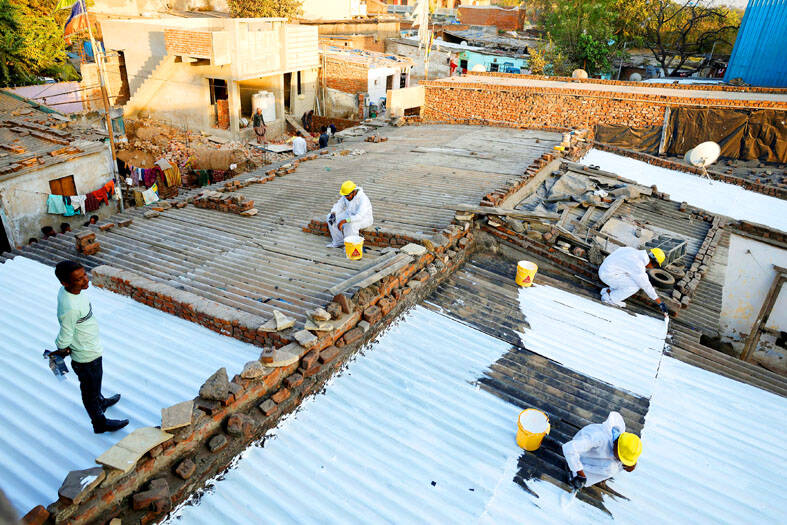Hundreds of roofs in the informal settlements of India’s western Gujarat state have been painted in a reflective, white coating over the past two months to try to keep their occupants cooler as the hottest time of the year approaches.
The effort, which involves 400 households in Ahmedabad, is part of a global scientific trial to study how indoor heat impacts people’s health and economic outcomes in developing nations — and how “cool roofs” might help.
“Traditionally, home is where people have come to find shelter and respite against external elements,” said Aditi Bunker, an epidemiologist at the University of Heidelberg in Switzerland who is leading the project, supported by the UK-based Wellcome Trust.

Photo: Reuters
“Now, we’re in this position where people are living in precarious housing conditions, where the thing that was supposed to be protecting them is actually increasing their exposure to heat,” she said.
As climate change has made India’s summers more extreme, Ahmedabad has suffered temperatures in excess of 46°C.
In the Vanzara Vas slum in the Narol area of the city, which has more than 2,000 dwellings, most of them airless, one-room homes, residents that are part of the project, such as Nehal Vijaybhai Bhil, say they have already noticed a difference.
“My refrigerator doesn’t heat up any more and the house feels cooler. I sleep so much better and my electricity bill is down,” said Bhil, whose roof was painted in January.
Across the world, heat waves that, prior to the industrial revolution, had a one-in-10 chance of occurring in any given year are nearly three times more likely, according to a 2022 study in the journal Environmental Research Letters.
By painting roofs with a white coating that contains highly reflective pigments such as titanium dioxide, Bunker and her team are sending more of the sun’s radiation back to the atmosphere and preventing it from being absorbed.
“In a lot of these low socioeconomic homes, there’s nothing to stop the heat transfer coming down — there’s no insulation barrier from the roof,” Bunker said.
Before joining Bunker’s experiment, Arti Chunara said she would cover her roof with plastic sheets and spread grass over them.
Some days, she and her family sat outside for most of the day, going into the house only for two to three hours when the heat was bearable.
The trial in Ahmedabad is to run for one year, and scientists are to collect health and indoor environment data from residents living under a cool roof — and from those who do not.
Other study sites are in Burkina Faso, Mexico and Niue in the South Pacific, spanning a variety of building materials and climates.
Early results from the Burkina Faso trial show that cool roofs reduced indoor temperature by between 1.2°C in tin and mud-roofed homes, and 1.7°C in tin-roofed homes over two years, which subsequently lowered residents’ heart rates, Bunker said.

TIT-FOR-TAT: The arrest of Filipinos that Manila said were in China as part of a scholarship program follows the Philippines’ detention of at least a dozen Chinese The Philippines yesterday expressed alarm over the arrest of three Filipinos in China on suspicion of espionage, saying they were ordinary citizens and the arrests could be retaliation for Manila’s crackdown against alleged Chinese spies. Chinese authorities arrested the Filipinos and accused them of working for the Philippine National Security Council to gather classified information on its military, the state-run China Daily reported earlier this week, citing state security officials. It said the three had confessed to the crime. The National Security Council disputed Beijing’s accusations, saying the three were former recipients of a government scholarship program created under an agreement between the

Sitting around a wrestling ring, churchgoers roared as local hero Billy O’Keeffe body-slammed a fighter named Disciple. Beneath stained-glass windows, they whooped and cheered as burly, tattooed wresters tumbled into the aisle during a six-man tag-team battle. This is Wrestling Church, which brings blood, sweat and tears — mostly sweat — to St Peter’s Anglican church in the northern England town of Shipley. It is the creation of Gareth Thompson, a charismatic 37-year-old who said he was saved by pro wrestling and Jesus — and wants others to have the same experience. The outsized characters and scripted morality battles of pro wrestling fit

ACCESS DISPUTE: The blast struck a house, and set cars and tractors alight, with the fires wrecking several other structures and cutting electricity An explosion killed at least five people, including a pregnant woman and a one-year-old, during a standoff between rival groups of gold miners early on Thursday in northwestern Bolivia, police said, a rare instance of a territorial dispute between the nation’s mining cooperatives turning fatal. The blast thundered through the Yani mining camp as two rival mining groups disputed access to the gold mine near the mountain town of Sorata, about 150km northwest of the country’s administrative capital of La Paz, said Colonel Gunther Agudo, a local police officer. Several gold deposits straddle the remote area. Agudo had initially reported six people killed,

SUSPICION: Junta leader Min Aung Hlaing returned to protests after attending a summit at which he promised to hold ‘free and fair’ elections, which critics derided as a sham The death toll from a major earthquake in Myanmar has risen to more than 3,300, state media said yesterday, as the UN aid chief made a renewed call for the world to help the disaster-struck nation. The quake on Friday last week flattened buildings and destroyed infrastructure across the country, resulting in 3,354 deaths and 4,508 people injured, with 220 others missing, new figures published by state media showed. More than one week after the disaster, many people in the country are still without shelter, either forced to sleep outdoors because their homes were destroyed or wary of further collapses. A UN estimate